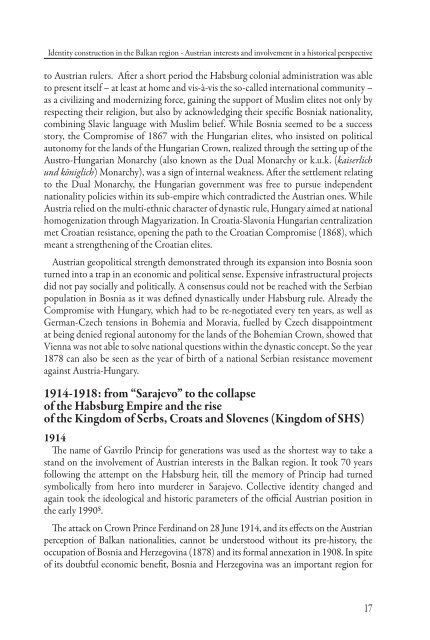free download in pdf format - Culturelink Network
free download in pdf format - Culturelink Network
free download in pdf format - Culturelink Network
You also want an ePaper? Increase the reach of your titles
YUMPU automatically turns print PDFs into web optimized ePapers that Google loves.
Identity construction <strong>in</strong> the Balkan region - Austrian <strong>in</strong>terests and <strong>in</strong>volvement <strong>in</strong> a historical perspective<br />
to Austrian rulers. Aft er a short period the Habsburg colonial adm<strong>in</strong>istration was able<br />
to present itself – at least at home and vis-à-vis the so-called <strong>in</strong>ternational community –<br />
as a civiliz<strong>in</strong>g and moderniz<strong>in</strong>g force, ga<strong>in</strong><strong>in</strong>g the support of Muslim elites not only by<br />
respect<strong>in</strong>g their religion, but also by acknowledg<strong>in</strong>g their specifi c Bosniak nationality,<br />
comb<strong>in</strong><strong>in</strong>g Slavic language with Muslim belief. While Bosnia seemed to be a success<br />
story, the Compromise of 1867 with the Hungarian elites, who <strong>in</strong>sisted on political<br />
autonomy for the lands of the Hungarian Crown, realized through the sett<strong>in</strong>g up of the<br />
Austro-Hungarian Monarchy (also known as the Dual Monarchy or k.u.k. (kaiserlich<br />
und königlich) Monarchy), was a sign of <strong>in</strong>ternal weakness. Aft er the settlement relat<strong>in</strong>g<br />
to the Dual Monarchy, the Hungarian government was <strong>free</strong> to pursue <strong>in</strong>dependent<br />
nationality policies with<strong>in</strong> its sub-empire which contradicted the Austrian ones. While<br />
Austria relied on the multi-ethnic character of dynastic rule, Hungary aimed at national<br />
homogenization through Magyarization. In Croatia-Slavonia Hungarian centralization<br />
met Croatian resistance, open<strong>in</strong>g the path to the Croatian Compromise (1868), which<br />
meant a strengthen<strong>in</strong>g of the Croatian elites.<br />
Austrian geopolitical strength demonstrated through its expansion <strong>in</strong>to Bosnia soon<br />
turned <strong>in</strong>to a trap <strong>in</strong> an economic and political sense. Expensive <strong>in</strong>frastructural projects<br />
did not pay socially and politically. A consensus could not be reached with the Serbian<br />
population <strong>in</strong> Bosnia as it was defi ned dynastically under Habsburg rule. Already the<br />
Compromise with Hungary, which had to be re-negotiated every ten years, as well as<br />
German-Czech tensions <strong>in</strong> Bohemia and Moravia, fuelled by Czech disappo<strong>in</strong>tment<br />
at be<strong>in</strong>g denied regional autonomy for the lands of the Bohemian Crown, showed that<br />
Vienna was not able to solve national questions with<strong>in</strong> the dynastic concept. So the year<br />
1878 can also be seen as the year of birth of a national Serbian resistance movement<br />
aga<strong>in</strong>st Austria-Hungary.<br />
1914-1918: from “Sarajevo” to the collapse<br />
of the Habsburg Empire and the rise<br />
of the K<strong>in</strong>gdom of Serbs, Croats and Slovenes (K<strong>in</strong>gdom of SHS)<br />
1914<br />
Th e name of Gavrilo Pr<strong>in</strong>cip for generations was used as the shortest way to take a<br />
stand on the <strong>in</strong>volvement of Austrian <strong>in</strong>terests <strong>in</strong> the Balkan region. It took 70 years<br />
follow<strong>in</strong>g the attempt on the Habsburg heir, till the memory of Pr<strong>in</strong>cip had turned<br />
symbolically from hero <strong>in</strong>to murderer <strong>in</strong> Sarajevo. Collective identity changed and<br />
aga<strong>in</strong> took the ideological and historic parameters of the offi cial Austrian position <strong>in</strong><br />
the early 1990s .<br />
Th e attack on Crown Pr<strong>in</strong>ce Ferd<strong>in</strong>and on 28 June 1914, and its eff ects on the Austrian<br />
perception of Balkan nationalities, cannot be understood without its pre-history, the<br />
occupation of Bosnia and Herzegov<strong>in</strong>a (1878) and its formal annexation <strong>in</strong> 1908. In spite<br />
of its doubtful economic benefi t, Bosnia and Herzegov<strong>in</strong>a was an important region for<br />
17



